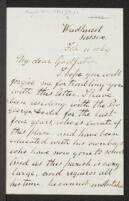Items D1/2-D1/51 were bundled together and marked "Notes up to 1927" by Sraffa. In most cases this date is our only evident terminus ante quem. Sraffa's own file titles are given in inverted commas
Items D1/54-90 were bundled together and marked "Notes 1928-31" by Sraffa although some items predate this. Items D1/54-68 formed a sub-bundle
Items D1/70-89 relate principally to the "circus" of economists who discussed Keynes' Treatise on Money
For notes used for the research for Production of Commodities by means of commodities see D3/12
View images of this item
Includes:
CB/173/1/43/2: Letter from Alexander William Phillips to his nephew Talbot M. M. Griffiths, 20 Jan. 1881.
CB/173/1/43/3: Letter from Ann Elizabeth Phillips to Talbot M. M. Griffiths, 20 Jan. [1881]
and letter from Rev. E. T. Mortlock
On books recommended for reading in relation to medieval ethics, including Gass' Geschichte der Christlichen Ethik, a volume of lectures by Neander, and Bettmann's Geschichte der Christichen Seite. Gives opinion as to the merits of each. Recommends especially Histoire des auteurs ecclesiastiques in 22 vols. by Ceillier, and 'the new edition' of Havreau. Mentions also Winter's book on the Ethics of the School of Alexandria and Jourdain's book on St Thomas. In relation to Hartmann's Phenomenology, claims it to be 'rude and spare' in the treatment of medieval theory, and comments that Sidgwick's 'enemy' Guyau 'knows nothing about it.' Mentions that his inability to verify the titles of his suggestions is due to the fact that he is ill in bed at the time of writing
Folder endorsed 'India General': 2 copies of Attock-on-the-Indus by George Adam Smith, with RAB's first letter to his grandmother, Mary Butler; scale drawing of elevation of mantle clock; programme of Lord and Lady Irwin's visit to Nagpur, 1926; essay on Attock by RAB; 2 silhouette caricatures of Butler family in Central Provinces; printed and typescript reports of 1931 Round Table Conference and Committees; speech notes; various letters and papers on Indian policy including report of meeting with W.S. Morrison, letters from Samuel and Maud Hoare, correspondence with Marquess of Dufferin and Ava, congratulations on House of Commons speech of 29 March 1933 and on leaving India Office, condolences on death of Sir Harcourt Butler in March 1939
Kirkaldy. Apologises for the letter sent the previous day
Delivered to the Literary Society, 15 Oct. 1881, enclosing 4 diagrams.
Congratulations on engagement.

